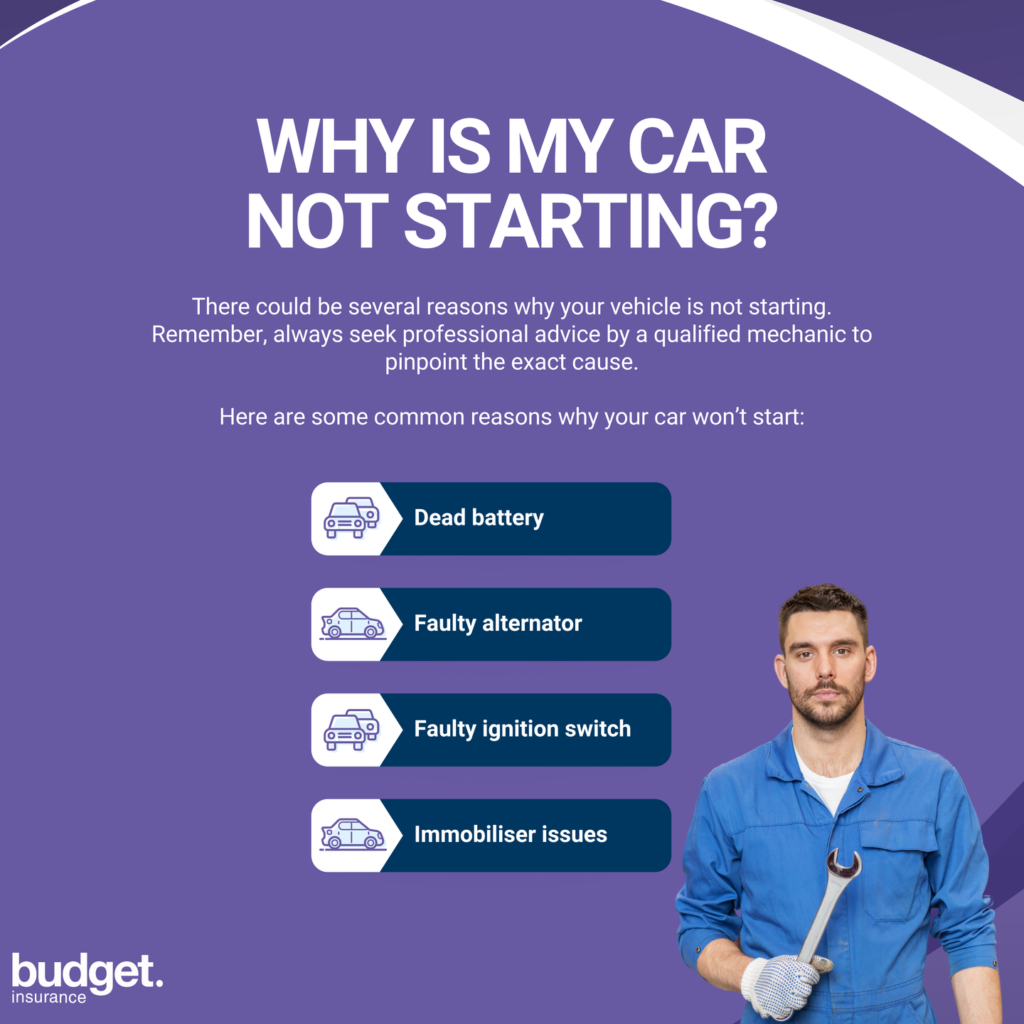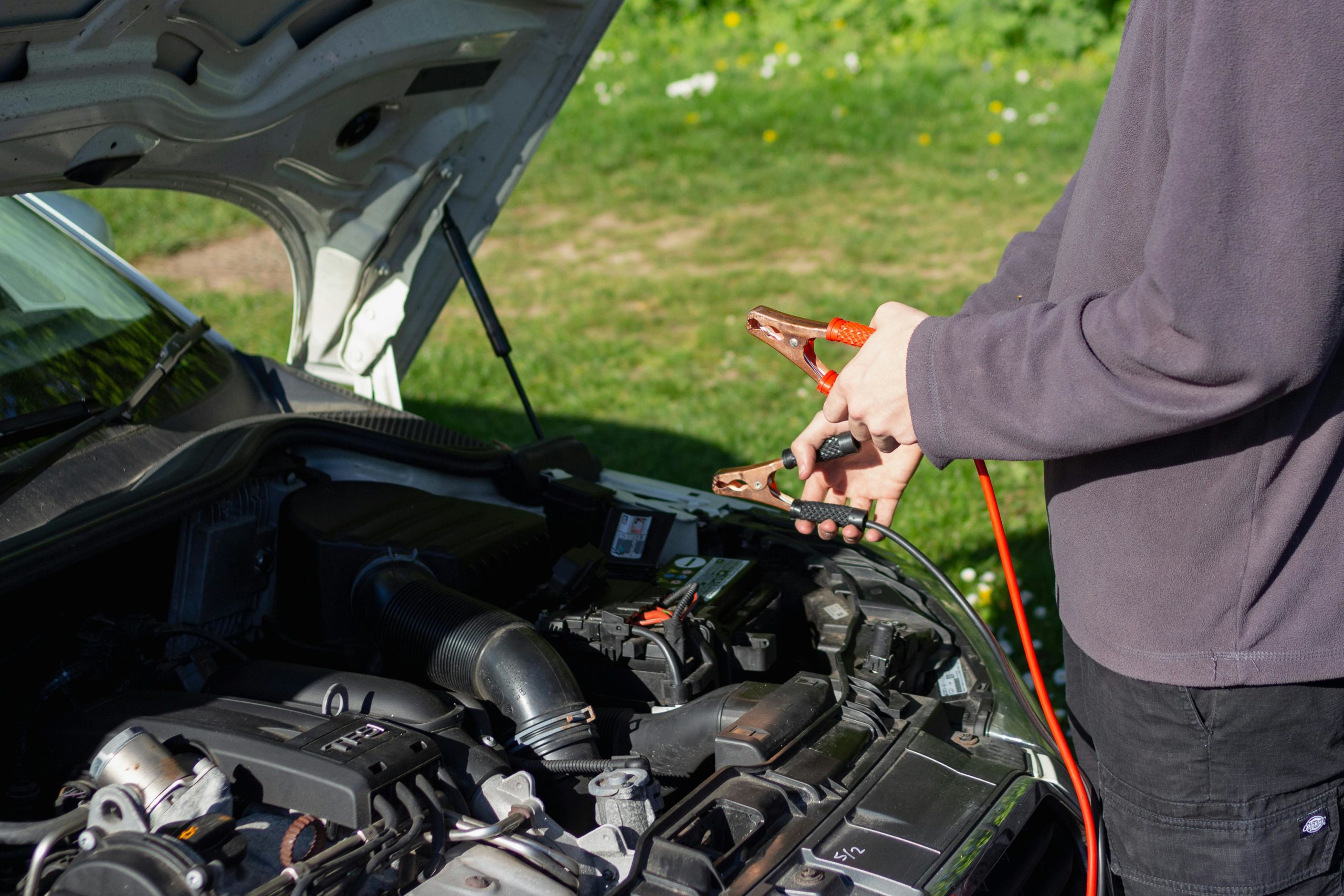Table of contents
Encountering a situation where your car doesn’t start can be an exasperating and unsettling experience, particularly when you’re pressed for time or stranded in an unfamiliar location. The most common reasons why your car is not starting is likely due to a dead battery, faulty alternator, faulty ignition switch, empty fuel tank and or immobiliser issues.
Dead or defective battery
One of the most prevalent reasons for a car’s failure to start is a dead or defective car battery. The battery serves as the heart of your vehicle’s electrical system, providing the initial jolt of power required to crank the engine and initiate the starting process.
Several factors can contribute to a battery’s demise, including age, extreme temperatures, excessive electrical draw from accessories left on, or a faulty alternator that fails to recharge the battery adequately.
Identifying a dead battery
If you turn the key and experience no response whatsoever – no cranking, no lights, no dashboard illumination – chances are high that your car’s battery has reached the end of its lifespan or has completely drained.
Additionally, if you notice dimming interior lights, sluggish power window operation, or a weak cranking sound when attempting to start the vehicle, these could be telltale signs of a dying battery.
Troubleshooting steps
-
Inspect the battery terminals and battery cables for corrosion, damage, or loose connections, as these can impede the flow of electrical current.
-
If the battery appears to be the issue, you can try jump-starting the car using jumper cables and another vehicle’s battery for a temporary solution.
-
However, if the battery is beyond its expected lifespan (typically 3-5 years), it may be prudent to replace it with a new one.
Can extreme weather impact my car not starting?
In cold conditions, the battery may struggle to provide sufficient power due to reduced chemical reactions, while thickened engine oil can impede the starter motor. Read our full guide on 10 ways to look after your car during winter months. Conversely, in extreme heat, batteries can overheat and lose efficiency, and fuel can evaporate, causing vapour lock issues.

Seeking professional assistance
While some of the issues may be resolved through basic troubleshooting steps and regular car maintenance, it’s important to recognise when professional assistance is required. Attempting to diagnose or repair complex mechanical or electrical problems without proper knowledge and tools can potentially lead to further damage or safety risks.
If you’ve exhausted the troubleshooting steps and your vehicle still refuses to start, it’s advisable to seek the expertise of a qualified mechanic. They have the necessary diagnostic equipment, specialised knowledge, and experience to accurately identify and rectify the underlying issue, ensuring your vehicle’s safe and reliable operation.
Faulty alternator
While a dead or faulty battery is often the prime suspect, a malfunctioning alternator can also be the root cause of your starting woes. The alternator recharges the battery and supplies power to the vehicle’s electrical components while the engine is running.
If the alternator fails, the battery will slowly drain and cause you to be be stranded.
Telltale signs of alternator failure
Dimming headlights or interior lights, especially when the engine is idling or under load (such as when using electrical accessories).
Battery warning light illuminated on the dashboard.
Difficulty starting the vehicle, even after a jump-start.
Rapid battery drainage, requiring frequent jump-starts or battery replacements.
Troubleshooting steps
Inspect the alternator belt for proper tension and signs of wear or damage.
Use a multi-meter to check the alternator’s output voltage, which should typically range between 13.5 and 14.5 volts when the engine is running.
If the alternator is faulty, it will need to be replaced by a qualified mechanic.
Starter motor malfunction
The starter motor is the component responsible for initiating the engine’s rotation during the starting process. If this essential component fails, you may find that your car won’t start, and you may hear clicking or grinding noises when attempting to start the vehicle, but the engine won’t crank over.
For peace of mind, get your vehicle protected with a car insurance policy from Budget Insurance.
Identifying a faulty starter motor
Listen for a single, solid click when turning the key, indicating that the starter motor is receiving power but unable to engage the flywheel.
Observe if the interior lights and accessories function normally, suggesting that the issue lies with the starter motor rather than the battery.
Check for any unusual noises, such as grinding or whirring, which could signify a mechanical issue within the starter motor itself.
Troubleshooting steps
Tap the starter motor gently with a solid object (like a hammer handle) while attempting to start the vehicle, as this may temporarily dislodge any internal components that are stuck.
If the tapping method fails, the starter motor will likely need to be replaced by a professional mechanic.
Immobiliser or security system glitches
In modern vehicles equipped with advanced security systems, a glitch in the immobiliser or a low key fob battery can prevent the engine from starting, even if all other components are functioning correctly.
Identifying immobiliser issues
Check for any warning lights or messages on the dashboard related to the security system or key fob.
Attempt to start the vehicle with a spare key fob (if available) to rule out a low battery in the primary fob.
Observe if the vehicle’s interior lights and accessories operate normally, indicating that the issue is not related to the battery or alternator.
Troubleshooting steps
Replace the key fob battery if it’s low or depleted.
Consult your vehicle’s owner’s manual or a professional mechanic for instructions on resetting or reprogramming the immobiliser system.
Fuel system failures
A disruption in the fuel delivery system can also prevent your vehicle from starting or cause it to stall shortly after starting. One common issue to check is the fuel pump relay, which ensures proper fuel delivery.
This could be due to a clogged fuel filter, a faulty fuel pump, or issues with the fuel injectors or fuel pressure regulator.
Signs of fuel system problems
Engine cranks but fails to start or immediately stalls after starting.
Sputtering or misfiring engine, indicating an inconsistent fuel supply.
Fuel gauge indicating an empty tank or a strong gasoline odor, suggesting a fuel leak.
Troubleshooting steps
Check the fuel level and refill the tank if necessary.
Replace the fuel filter if it appears clogged or hasn’t been changed in a while.
Listen for any whirring or buzzing noises coming from the fuel tank area, which could indicate a failing fuel pump.
If the issue persists, seek professional assistance to diagnose and repair any faulty components in the fuel delivery system.
Ignition switch failure
The ignition switch is the component responsible for transferring electrical power from the battery to the starter motor and other electrical systems when the key is turned. If this switch fails, it can prevent the engine from receiving the necessary electrical signal to start.
Identifying ignition switch issues
Observe if the dashboard lights and accessories remain inoperative when turning the key, suggesting a problem with the ignition switch.
Check for any difficulty in inserting or turning the key in the ignition.
Listen for any clicking or grinding noises when attempting to start the vehicle, which could indicate a mechanical issue with the ignition switch.
Troubleshooting steps
Gently wiggle the steering wheel while turning the key, as this may temporarily alleviate any binding or sticking issues with the ignition switch.
If the issue persists, the ignition switch may need to be replaced by a qualified mechanic.
Spark plugs
Faulty or worn-out spark plugs can also contribute to starting difficulties, as they play a crucial role in igniting the air-fuel mixture within the engine cylinders. When there is too much fuel and not enough air, it can prevent the spark plugs from working properly.
Signs of spark plug issues
Engine misfiring or rough idling, indicating incomplete combustion.
Difficulty starting the engine, especially when cold.
Reduced fuel efficiency and performance.
Troubleshooting steps
Check the condition of the spark plugs and replace them if they appear fouled, damaged, or have exceeded their recommended service life.
Ensure that the spark plug wires are properly connected and in good condition.
If the issue persists after replacing the spark plugs, further diagnosis may be required to identify any underlying ignition system problems.
Timing belt or chain failure
The timing belt or chain is responsible for synchronising the movement of the camshafts and crankshaft, ensuring that the valves open and close at the precise moments during the engine’s combustion cycle.
A flooded engine, where excessive fuel prevents the engine from starting properly, can also be a cause of starting issues. If this component fails, it can prevent the engine from starting or running properly.
Identifying timing belt/Chain issues
Engine cranks but fails to start or runs erratically.
Unusual noises, such as rattling or slapping, coming from the engine compartment.
Check engine light illuminated, indicating a potential timing issue.
Troubleshooting steps
Inspect the timing belt or chain for any visible damage, such as cracks, fraying, or excessive wear.
Replace the timing belt or chain according to the manufacturer’s recommended service intervals, as failure to do so can result in costly engine damage.
If the timing belt or chain has failed, seek professional assistance immediately, as attempting to start the engine could cause further damage.
Jammed steering lock
In some cases, a jammed steering lock can prevent the key from turning in the ignition, effectively immobilising the vehicle.
Identifying a jammed steering lock
The key refuses to turn in the ignition, or only turns partially.
Attempting to turn the steering wheel while the vehicle is stationary may reveal a binding or locking mechanism.
Troubleshooting steps
Gently rock the steering wheel back and forth while applying light pressure to the key, as this may help dislodge any binding in the steering lock mechanism.
If the issue persists, consult a professional mechanic, as attempting to forcibly turn the key could damage the ignition system.
Clogged fuel filter
A clogged fuel filter can restrict the flow of fuel to the engine, preventing it from starting or causing it to stall shortly after starting.
Signs of a clogged fuel filter
Engine hesitation or misfiring, indicating an inconsistent fuel supply.
Reduced fuel efficiency and performance.
Engine stalling or failing to start, especially after extended idling or low fuel levels.
Troubleshooting steps
Replace the fuel filter according to the manufacturer’s recommended service intervals or if it appears excessively clogged.
Ensure there are no leaks or obstruction within the fuel lines and connections
If the issue persists after replacing the fuel filter, further diagnosis may be required to identify any underlying fuel system problems.
Empty fuel tank
While it may seem obvious, running out of fuel is a common reason for a vehicle not starting, especially if the fuel gauge is malfunctioning or inaccurate.
Identifying an empty fuel tank
Check the fuel gauge and refill the tank if it’s indicating empty or close to empty.
Listen for any unusual noises or sputtering from the engine, which could indicate a lack of fuel.
Troubleshooting steps
Refill the fuel tank with the appropriate type of fuel for your vehicle.
If the fuel gauge appears to be not working correctly, take your car to a garage for repair.
Conclusion
Remember, regular maintenance and adhering to the manufacturer’s recommended service intervals can go a long way in preventing many of these starting problems from occurring in the first place. If you’re ready to explore your car insurance options, get covered today with Budget insurance! By staying vigilant and addressing any potential issues promptly, you can minimise the frustration and inconvenience of a non-starting vehicle.
